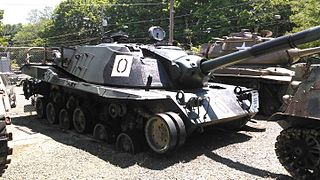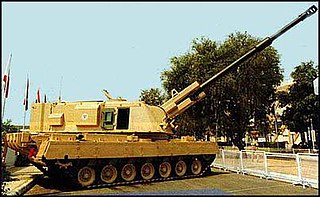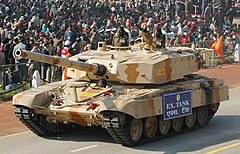
The MBT-70 was an American–West German joint project to develop a new main battle tank during the 1960s.

The T-84 is a Ukrainian main battle tank (MBT), based on the Soviet T-80 MBT introduced in 1976, specifically the diesel engine version: T-80UD. The T-84 was first built in 1994 and entered service in the Ukrainian Armed Forces in 1999. Its high-performance opposed-piston engine makes it a fast tank, comparable to other modern MBTs with a power-to-weight ratio of about 26 horsepower per tonne.

The Arjun is a third generation main battle tank developed by the Combat Vehicles Research and Development Establishment (CVRDE) of the Defence Research and Development Organisation (DRDO), for the Indian Army. The tank is named after Arjuna, the archer prince who is the main protagonist of the Indian epic poem Mahabharata. Design work began in 1986 and was finished in 1996. The Arjun main battle tank entered service with the Indian Army in 2004. The 43rd Armoured Regiment, formed in 2009, was the first regiment to receive the Arjun.

The PT-91 Twardy is a Polish main battle tank. A development of the T-72M1, it entered service in 1995. The PT-91 was designed at the OBRUM and is produced by the Bumar Łabędy company, part of the Bumar Group, a Polish technical military consortium. Changes from the T-72M include a new dual-axis stabilized fire-control system, reactive armour, a more powerful engine, transmission and new automatic loader.

The C1 Ariete is a 3rd generation main battle tank of the Italian Army, developed by Consorzio Iveco Oto Melara (CIO), a consortium formed by IVECO and OTO Melara. The chassis and engine were produced by Iveco, while the turret and fire-control system were supplied by OTO Melara. The vehicle carries the latest optical and digital-imaging and fire-control systems, enabling it to fight day and night and to fire on the move. Six prototypes were developed by 1988, which were subject to intensive testing. The following year the vehicles travelled a combined 16,000 km. Deliveries were first planned for 1993, and took place in 1995 due to delays. Final delivery occurred 7 years later in August 2002.

The FV4201 Chieftain was the main battle tank of the United Kingdom during the 1960s–1990s.

The Type 99 or ZTZ-99 is a Chinese third generation main battle tank (MBT). The vehicle was a replacement for the aging Type 88 introduced in the late 1980s. The Type 99 MBT was China's first mass-produced third-generation main battle tank. Combining modular composite armour and tandem-charge defeating ERA, 125 mm smoothbore gun with ATGM-capability, high mobility, digital systems and optics, the Type 99 represents a shift towards rapid modernization by the PLA.

The Al-Khalid is a Pakistani main battle tank developed by Heavy Industries Taxila since the 1990s. It is based on the Chinese Type 90-IIM tan, whose original prototype was developed by China North Industries Corporation (Norinco) under the name MBT-2000. Around 310 Al Khalid MBTs had been produced by 2014.

An armoured vehicle-launched bridge (AVLB) is a combat support vehicle, sometimes regarded as a subtype of military engineering vehicle, designed to assist militaries in rapidly deploying tanks and other armoured fighting vehicles across gap-type obstacles, such as rivers. The AVLB is usually a tracked vehicle converted from a tank chassis to carry a folding metal bridge instead of weapons. The AVLB's job is to allow armoured or infantry units to cross craters, anti-tank ditches, blown bridges, railroad cuts, canals, rivers and ravines, when a river too deep for vehicles to wade through is reached, and no bridge is conveniently located, or sufficiently sturdy, a substantial concern when moving 60-ton tanks.

The BMPT "Terminator" is an armored fighting vehicle (AFV), designed and manufactured by the Russian company Uralvagonzavod. This vehicle was designed for supporting tanks and other AFVs in urban areas. The BMPT is unofficially named the "Terminator" by the manufacturers. It is heavily armed and armored to survive in urban combat. The AFV is armed with four 9M120 Ataka missile launchers, two 30 mm 2A42 autocannons, two AG-17D grenade launchers, and one coaxial 7.62 mm PKTM machine gun.

The Type 80 and the Type 88 are a family of Chinese second-generation main battle tanks (MBTs). They are also known as the ZTZ80 and ZTZ88.

The AMX-40 was a French main battle tank developed by GIAT during the latter stages of the Cold War as an export tank to replace the earlier AMX-32. Designed to be an inexpensive tank orientated towards militaries with smaller defence budgets, the AMX-40 featured a lightly armoured hull and good mobility reminiscent of previous French MBTs with a powerful 120 mm cannon. It however failed to attract interest and sales, rendering the project a failure, being discontinued in 1990.
Combat Vehicles Research and Development Establishment (CVRDE) is a laboratory of the Defence Research and Development Organisation (DRDO). Located at Avadi, in Chennai, India. It is the main DRDO lab involved in the development of Armoured fighting vehicles, Tanks, Automotive electronics and many other.
The Proof and Experimental Establishment (PXE) is an Indian defence laboratory of the Defence Research and Development Organisation (DRDO). Located in Balasore, Orissa, India. its main purpose concerns the research and development of technologies and products in the area of medium and large caliber weapons and their ammunition. PXE is organised under the Armament and Combat Engineering Cluster of DRDO.

The Vijayanta was a main battle tank built in India based on a licensed design of the Vickers Mk.1. The Vijayanta was the first indigenous tank of the Indian Army.

Abhay is an Infantry Combat Vehicle (ICV) being developed in India by the Defence Research and Development Organisation (DRDO). Abhay is being developed as a technology demonstrator for replacing Indian Army BMP-2s.

The T-72 is a Soviet-designed main battle tank that entered production in 1971. It replaced the T-54/55 series as the workhorse of Soviet tank forces. In front-line Russian service, T-72s are being upgraded or augmented by the T-90, itself a modernized version of the T-72B. The T-72 has been exported and produced in many countries.

The Bhim self-propelled howitzer is a type of self-propelled artillery developed by the South African company Denel under the supervision of the Indian Defence Research and Development Organisation. It was designed to meet the Indian Army's requirements for self-propelled artillery units. The howitzer is named after Bhima, one of the main protagonists and brother to Arjun of the Indian epic "Mahabharata".
The post–Cold War era is the period in world history from the collapse of the Soviet Union on December 27, 1991 to the present. During the Cold War, the Soviet domination of the Warsaw Pact led to effective standardization on a few tank designs. In comparison, France, Germany, the United States, and the United Kingdom had previously developed their own tank designs, but now tried to standardize their designs, while the smaller nations of NATO purchased or adapted these designs.

The Type 59G Durjoy, sometimes known as Type 59G, is a highly modernized version of the Chinese Type 59 tank for the Bangladesh Army. The Bangladesh Army's old Type 59 tanks were upgraded similarly to Type 59G standard at 902 Central Workshop of the Bangladesh Machine Tools Factory with Chinese assistance.

















